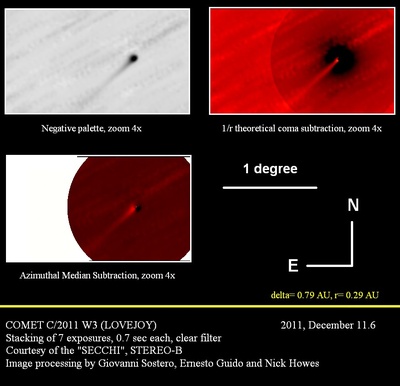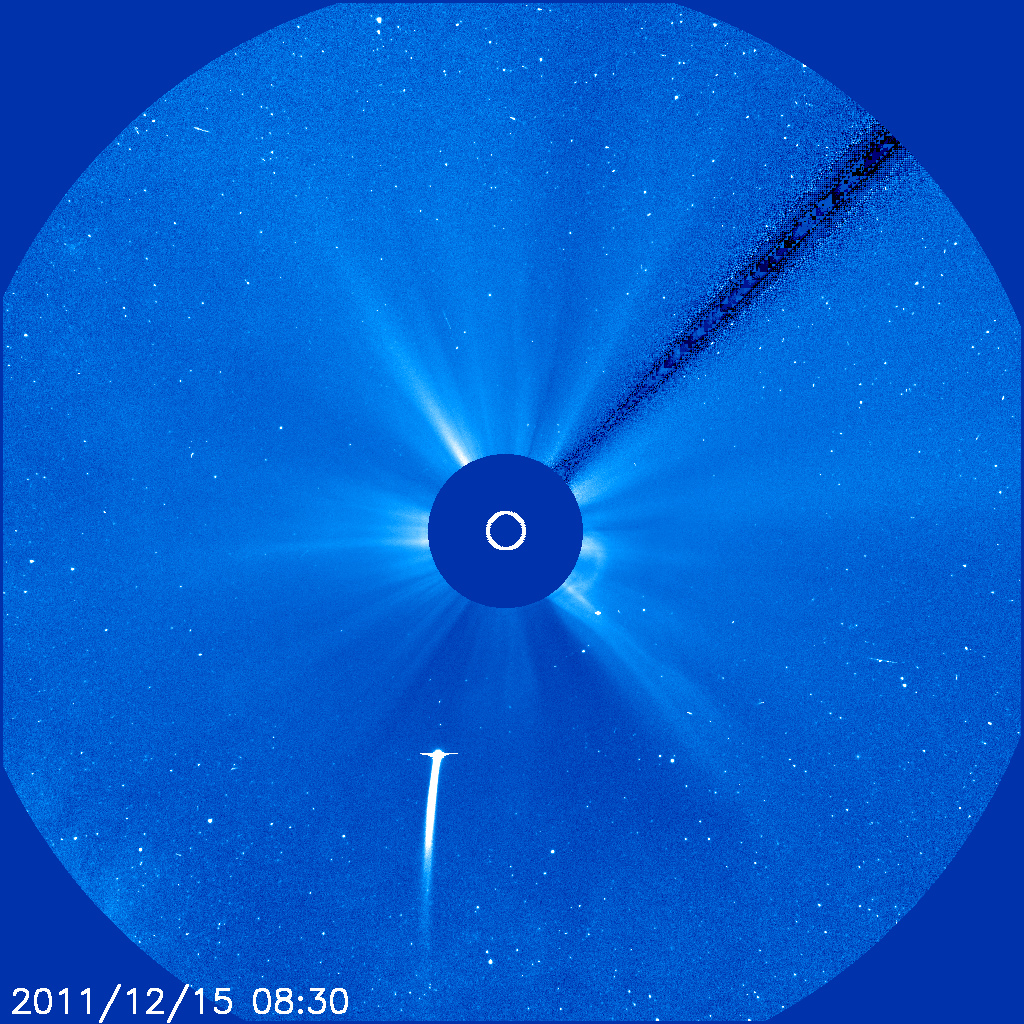Comet C/2011 W3 (Lovejoy) approaches the Sun
C/2011 W3 is a Kreutz sungrazer, a family of sungrazing comets that are named after German astronomer Heinrich Kreutz who first studied them in the details. These comet fragments passes extremely close to the Sun at perihelion and usually they completely evaporated during such a close approach.
Many Kreutz sungrazer comets are observed each year by SOHO Sun-observing satellite. SOHO provides a constant view of the immediate solar vicinity and it has now discovered more than 2000 of new sungrazing comets, some just a few metres across. About 83% of the sungrazers found by SOHO are members of the Kreutz group, with the other being referred to as 'non-Kreutz' or 'sporadic' sungrazers (Meyer, Marsden, and Kracht 1 & 2 families).
Comet C/2011 W3 will probably be the brightest Kreutz-group comet that SOHO has ever observed. It will reach the perihelion on 2011 Dec. 16.02 when it will be it within 880,000 km of the center of the Sun (the comet will pass just 180,000 km from the Sun’s surface).
According to Karl Battams, the new comet Lovejoy:
1. The comet should enter the STEREO/SECCHI HI-1B images on Dec 11, and HI-1A on Dec 12
2. The comet will enter the SOHO/LASCO C3 field of view early on Dec 14
3. The comet will enter the STEREO/SECCHI COR-2 A & B fields of view early on Dec 15 (UT time), and the COR-1 fields later that day.
We downloaded "Secchi" spacecraft FITS of the Dec. 11 & 12, 2011, and played a little bit with them. Using the image processing algorythms (developed for the CARA collaboration by our fellow collaborator Martino Nicolini). On those images, it's already possible to appreciate a narrow tail, in excess of about 1 deg. Above you can see our renditions (click on the images for a bigger version):
While below you can see an animation showing comet Lovejoy in SECCHI HI-1B on December 11 & 12, 2011 (click on the thumbnail for a bigger version).
According to Dr. Matthew Knight (Lowell Observatory/JHU-APL), Comet Lovejoy was at approximately magnitude 2.0 as on the LASCO C3 images of 16:32UT, Dec 14, 2011). While the peak magnitude is still uncertain, C/2011 W3 could reach the peak brightness at mag -3 or -4 and the comet will probably not survive perihelion. If Comet Lovejoy gets as bright as magnitude -4 or -5, there is a tiny but non-zero chance that it could become visible in the sky next to the sun. But extreme care is needed due to the comet's small solar elongation angle and close proximity to the Sun in the sky.
Below you can see the comet on latest LASCO C3 data available (08:30UT of December 15, 2011). Click on it for a bigger version:
A new narrow tail is visible in these images. This extremely narrow features recalls the Na or Fe tails already featured on a few extremely bright comets close to the Sun, e.g.: http://tinyurl.com/cck9pbn and http://tinyurl.com/ctun5cy
Matthew Knight of the Lowell Observatory and JHU-APL reports on Spaceweather website: "As of 16:30 UT on Dec. 15th, Comet Lovejoy has reached magnitude -3, possibly brighter. It is starting to saturate SOHO images even with narrow filters and shorter than normal exposure times." The comet is now brighter than Jupiter, but not quite as bright as Venus. If these developments continue apace, Comet Lovejoy could become visible to the naked eye in broad daylight before the end of Dec. 15th.
Again: extreme care is needed due to the comet's small solar elongation angle and close proximity to the Sun in the sky. Do not look at or near the sun through unfiltered optics; focused sunlight can seriously damage your eyes.
Comet Lovejoy's perihelion is roughly 5 hours from now, on Dec 16 at 00:30UT. Next SOHO images will be available after 22:20UT.
Thanks to Karl, new STEREO-B, SECCHI fits dated back to December 13, 2011 are available. In spite of the fact that the image scale factor is a little small, it's possible to appreciate the growing of a slight asymmetry of the coma (toward the north-east):


